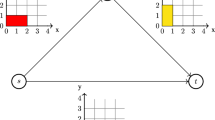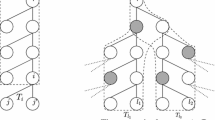Abstract
We present a new scaling algorithm for the maximum mean cut problem. The mean of a cut is defined by the cut capacity divided by the number of arcs crossing the cut. The algorithm uses an approximate binary search and solves the circulation feasibility problem with relaxed capacity bounds. The maximum mean cut problem has recently been studied as a dual analogue of the minimum mean cycle problem in the framework of the minimum cost flow problem by Ervolina and McCormick. A networkN=(G, lower, upper) with lower and upper arc capacities is said to be δ-feasible ifN has a feasible circulation when we relax the capacity bounds by δ; that is, we use (lower(a)- δ, upper(a)+δ) bounds instead of (lower(a), upper(a)) bounds for each arca εA. During an approximate binary search we maintain two bounds,LB andUB, such thatN is LB-infeasible andUB-feasible, and we reduce the interval size (LB, UB) by at least one-third at each iteration. For a graph withn vertices, m arcs, and integer capacities bounded byU, the running time of this algorithm is O(mn log(nU). This time bound is better than the time achieved by McCormick and Ervolina under thesimilarity condition (that is,U=O(no(1))). Our algorithm can be naturally used for the circulation feasibility problem, and thus provides a new scaling algorithm for the minimum cut problem.
Similar content being viewed by others
References
R. K. Ahuja and J. B. Orlin, A Fast and Simple Algorithm for the Maximum Flow Problem,Oper. Res., 37(5):748–759, 1990.
R. K. Ahuja, J. B. Orlin, and R. E. Tarjan, Improved Time Bounds for the Maximum Flow Problem,SIAM J. Comput. 18:939–954, 1989.
E. A. Dinic, Algorithm for Solution of a Problem of Maximum Flow in Networks with Power Estimation,Soviet Math. Dokl., 11:1277–1280, 1970.
J. Edmonds and R. M. Karp, Theoretical Improvements in Algorithmic Efficiency for Network Flow Problems,J. Assoc. Comput. Mach., 19:248–264, 1978.
T. R. Ervolina and S. T. McCormick, A Strongly Polynomial Maximum Mean Cut Cancelling Algorithm for Minimum Cost Network Flow, Working Paper 90-MSC-009, Faculty of Commerce, University of British Columbia, May 1990.
T. R. Ervolina and S. T. McCormick, A Strongly Polynomial Dual Cancel and Tighten Algorithm for minimum Cost Network Flow, Working Paper 90-MSC-010, Faculty of Commerce, University of British Columbia, May 1990.
A. V. Goldberg and R. E. Tarjan, A New Approach to the Maximum-Flow Problem,J. Assoc. Comput. Mach., 35(4):921–940, 1988.
A. V. Goldberg and R. E. Tarjan, Finding Minimum-Cost Circulations by Canceling Negative Cycles,J. Assoc. Comput. Mach., 36(4):873–886, 1989.
M. Gondran and M. Minoux,Graphs and Algorithms (trans. S. Vajda), Wiley, New York, 1984.
R. Hassin, Algorithms for the minimum Cost Circulation Problem in Cycles, Based on Maximizing the Mean Improvement, February 1990.
J. C. Herz, Course de Théorie des graphes, Faculté des Science de Lille, 1967.
A. J. Hoffman, Some Recent Applications of the Theory of Linear Inequalities to Extremal Combinatorial Analysis. InCombinatorial Analysis, (Proc. 10th Symp. on Applied Mathematics, Columbia University, 1958) (R. E. Bellman and M. Hall, eds.), American Mathematical Society, Providence, RI, pp. 113–127, 1958.
R. M. Karp, A Characterization of the Minimum Cycle Mean in a Digraph,Discrete Math., 23:309–311, 1978.
E. L. Lawler,Combinatorial Optimization: Networks and Matroids, Holt, Rinehart and Winston, New York, 1978.
S. T. McCormick, Private communication, 1991.
S. T. McCormick and T. R. Ervolina, Computing Maximum Mean Cuts, Working Paper 90-MSC-011, Faculty of Commerce, University of British Columbia, May 1990.
G. J. Minty, On the Axiomatic Foundations of the Theories of Directed Linear Graphs, Electrical Networks and Network Programming,J. Math. Mech., 15:485–520, 1966.
D. Naor, D. Gusfield, and C. Martel, A Fast Algorithm for Optimally Increasing the Edge-Connectivity.Proc. 31st Annual Symposium on Foundations of Computer Science, pp. 698–707, 1990.
J. B. Orlin, A Faster Strongly Polynomial Minimum Cost Flow Algorithm,Proc. 20th ACM Symposium on the Theory of Computing, pp. 377–387, 1988.
J. B. Orlin and R. K. Ahuja, New Scaling Algorithms for the Assignment and Minimum Cycle Mean Problems, Technical Report OR 178-88, Operations Research Center, MIT, May 1988.
E. Zemel, A Linear Time Randomizing Algorithm for Searching Ranked Functions,Algorithmica, 2:81–90, 1987.
Author information
Authors and Affiliations
Additional information
Communicated by Harold N. Gabow.
Research supported by a grant-in-aid of the Ministry of Education, Science and Culture of Japan.
Rights and permissions
About this article
Cite this article
Iwano, K., Misono, S., Tezuka, S. et al. A new scaling algorithm for the maximum mean cut problem. Algorithmica 11, 243–255 (1994). https://doi.org/10.1007/BF01240735
Received:
Revised:
Issue Date:
DOI: https://doi.org/10.1007/BF01240735




